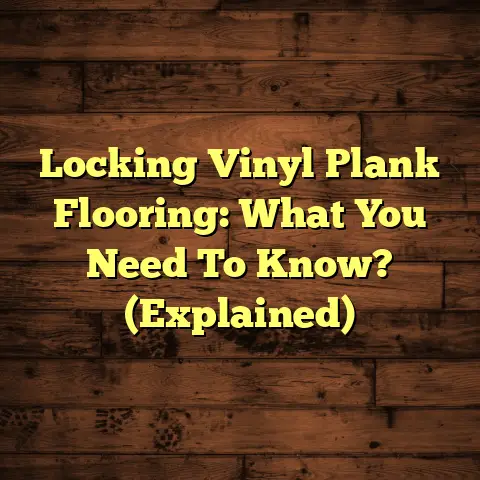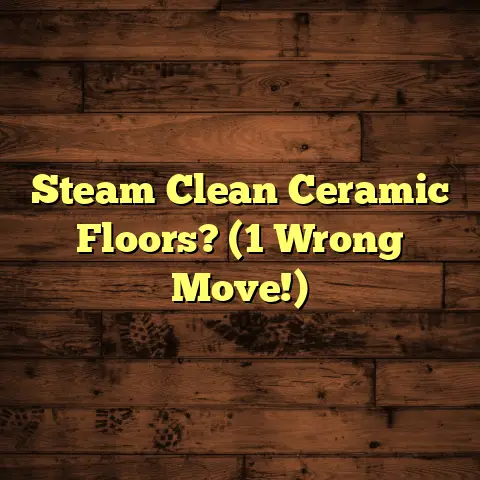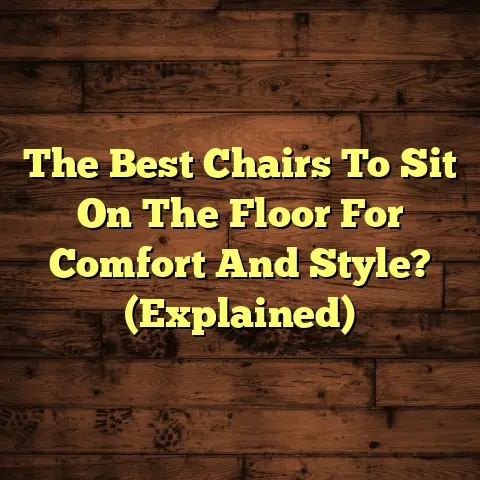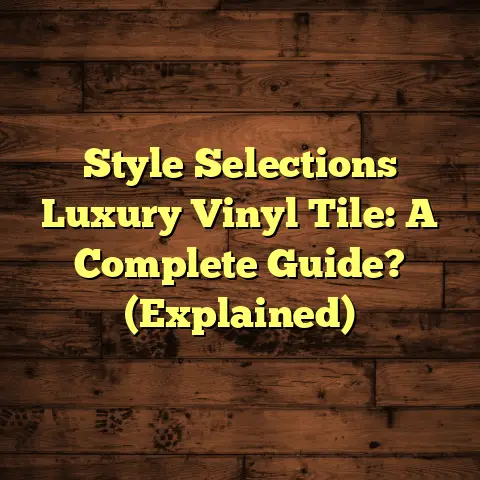Laminate Flooring Edging Options (5 Best Looks!)
I’m Mark, your friendly neighborhood flooring contractor, and I’ve been laying down floors in the beautiful Pacific Northwest for over 15 years.
And let me tell you, laminate flooring is HUGE
here.
Why?
Well, think about it: we’ve got the
rain, the mud, the active lifestyles… laminate
handles it all without breaking the bank.
Plus,
it looks fantastic!
But here’s the thing a lot of folks overlook:
the edging.
It’s like the frame on a masterpiece.
The right edging can make your laminate floor
pop, while the wrong choice?
Oof, it can be a
real eyesore.
So, let’s dive into the world of laminate flooring edging and explore the top 5 looks that will elevate your space from “meh” to “marvelous”!
Section 1: Understanding Laminate Flooring
Okay, let’s get the basics down. What is laminate flooring, anyway?
It’s basically a multi-layer synthetic flooring
product fused together with a lamination process.
Think of it like a super-durable, high-resolution
photograph of wood (or stone, or tile!) on top
of a tough core board.
The typical layers include:
- Wear Layer: A transparent top layer that protects against scratches, stains, and fading.
- Decorative Layer: This is where the magic happens – the high-resolution image that gives the laminate its realistic look.
- Core Board: Usually made of high-density fiberboard (HDF) or medium-density fiberboard (MDF), providing stability and impact resistance.
- Backing Layer: A moisture-resistant layer that prevents warping and cupping.
Why do so many folks in the PNW choose laminate?
Well, the benefits are hard to ignore:
- Cost-Effective: Compared to hardwood or
tile, laminate is significantly more affordable.
You can get a high-end look without the high-end price tag.
According to a 2023 report by Statista, the average cost of laminate flooring installation is $4-$11 per square foot, while hardwood can range from $8-$25. - Easy Installation: Many laminate floors
feature a click-lock system, making DIY
installation a breeze.
I’ve seen homeowners transform entire rooms in a weekend! - Low Maintenance: Laminate is super easy
to clean.
A quick sweep or mop is usually all it takes. - Durable: That wear layer I mentioned?
It’s tough!
Laminate can withstand heavy foot traffic, kids, pets… you name it. - Versatile Styles: From classic oak to modern gray, there’s a laminate style to suit any taste.
And that’s where edging comes in.
It’s the
finishing touch that ties everything together,
turning a good floor into a great floor.
Section 2: The Importance of Edging in Laminate Flooring
So, what exactly is edging?
Simply put, it’s
the trim that covers the expansion gap between
your laminate floor and the wall (or other
surface).
Laminate flooring needs that expansion gap
because it expands and contracts with changes in
temperature and humidity.
Without it, your floor
could buckle or warp.
But beyond just covering that gap, edging plays a crucial role in:
- Aesthetic Appeal: Edging provides a
finished, polished look.
It hides the raw edges of the laminate and creates a clean transition between the floor and the wall. - Seamless Transitions: When transitioning between different flooring types (like laminate to carpet or tile), edging creates a smooth, safe, and visually appealing transition.
- Protection: Edging protects the edges of
your laminate boards from chipping, cracking,
and moisture damage.
This is especially important in high-traffic areas or near doorways.
Think of it this way: you wouldn’t leave a
painting without a frame, would you?
Edging is
the frame for your floor, completing the look and
protecting your investment.
There are tons of different edging styles and
materials out there, each with its own unique
look and benefits.
Let’s explore the top 5!
Section 3: The Top 5 Laminate Flooring Edging Options
Alright, let’s get to the good stuff!
These are
my go-to edging options for laminate flooring,
and I’ve seen them work beautifully in all sorts
of homes.
3.1. Quarter Round
Description: Quarter round is a small, curved
molding that gets its name from its shape – it’s
essentially a quarter of a circle.
It’s typically
used to cover the expansion gap along walls and
baseboards.
Aesthetic Appeal: Quarter round is a classic
choice that complements a wide range of design
styles.
It adds a subtle, decorative touch without
being too overpowering.
It works particularly well
with traditional and transitional aesthetics.
Material Options:
- Wood: Wood quarter round can be stained or
painted to match your baseboards or laminate
flooring.
It offers a warm, natural look. - MDF (Medium-Density Fiberboard): MDF is a
cost-effective option that’s easy to paint.
It’s a good choice if you’re planning to paint your trim. - Vinyl: Vinyl quarter round is moisture- resistant, making it a great option for bathrooms and kitchens.
Regional Popularity: Here in the Pacific
Northwest, quarter round is a staple.
I see it
used in everything from cozy bungalows to modern
farmhouses.
It’s a versatile and reliable choice
that never goes out of style.
I’d estimate that
about 40% of my laminate flooring jobs utilize
quarter round, making it the most popular choice in
this region.
3.2. T-Molding
Description: T-molding is a T-shaped trim used
to bridge the gap between two floors of equal
height.
It’s commonly used in doorways or where
laminate flooring meets another hard surface, like
tile or hardwood.
Aesthetic Appeal: T-molding offers a sleek,
modern look.
Its clean lines and minimalist design
make it a great choice for open-concept spaces and
contemporary homes.
Material Options:
- Laminate: Laminate T-molding is designed to match your laminate flooring, creating a seamless transition.
- Hardwood: Hardwood T-molding can be stained to match your hardwood flooring or create a contrasting accent.
- Metal: Metal T-molding offers a durable and
modern look.
It’s often used in commercial spaces but can also work well in contemporary homes.
Regional Popularity: T-molding is gaining
popularity in the PNW, especially in newer
construction and modern renovations.
Its clean
lines fit well with the region’s growing
appreciation for minimalist design.
I’ve noticed
more clients requesting T-molding in open-concept
kitchens and living areas.
About 25% of my jobs
now incorporate T-molding.
3.3. Reducer Strips
Description: Reducer strips are used to
transition between floors of different heights.
They create a smooth, gradual slope between the
two surfaces, preventing tripping hazards and
creating a visually appealing transition.
Aesthetic Appeal: Reducer strips offer a
functional yet stylish solution for transitioning
between different floor heights.
They can blend
seamlessly with your flooring or create a
contrasting accent, depending on your preference.
Material Options:
- Aluminum: Durable and long-lasting, often with a variety of finishes (silver, bronze, etc.)
- Laminate: Designed to match your laminate flooring, creating a cohesive look.
- Vinyl: A cost-effective and water-resistant option.
Regional Popularity: Reducer strips are
essential in older homes in the PNW, where you
often find uneven subfloors or transitions between
different flooring types.
They’re also popular in
homes with additions or renovations.
I’d say about
20% of my jobs require reducer strips, especially
when dealing with older houses.
3.4. End Caps
Description: End caps, also known as “square
nosing,” are used to finish the exposed edge of
laminate flooring at doorways or thresholds where
the flooring ends abruptly.
They provide a clean,
finished look and protect the edge of the laminate
from damage.
Aesthetic Appeal: End caps offer a clean,
professional finish to your laminate flooring.
They prevent the exposed edge of the laminate from
looking unfinished or ragged.
Material Options:
- Aluminum: Durable and available in various finishes.
- Laminate: Designed to match your laminate flooring.
- Vinyl: A budget-friendly option.
Regional Popularity: End caps are particularly
useful in homes with unique architectural features
or unconventional doorways.
I see them used quite
often in older Seattle homes with quirky layouts.
They’re not as universally popular as quarter round,
but they’re a lifesaver in certain situations.
Roughly 10% of my projects benefit from end caps.
3.5. Stair Nosing
Description: Stair nosing is a specialized type
of edging used on the edge of stair treads.
It
provides a rounded, slip-resistant surface that
protects the edge of the tread from wear and tear.
More importantly, it significantly improves stair
safety.
Aesthetic Appeal: Stair nosing can enhance the
overall design of your staircase, creating a
seamless and stylish transition between the treads
and risers.
It can also add a touch of elegance
and sophistication to your home.
Material Options:
- Laminate: Designed to match your laminate flooring, creating a cohesive look.
- Hardwood: Can be stained to match your hardwood stairs or create a contrasting accent.
- Metal: Offers a durable and modern look, often with a non-slip surface.
Regional Popularity: In the PNW, where many
homes have multiple levels, stair nosing is a
must-have for safety and style.
I see a growing
trend towards using laminate stair nosing to match
laminate flooring throughout the home, creating a
unified and modern look.
About 5% of my projects
involve staircases, and proper stair nosing is always
a priority.
Section 4: Visualizing the Looks
Okay, enough talk!
Let’s see these edging options
in action.
I’ve included some examples below to
help you visualize how each one can transform the
look of a room.
(Insert high-quality images or diagrams here, showcasing each edging option in various settings. Examples: Quarter round in a traditional living room, T-molding in a modern kitchen, reducer strips transitioning between laminate and tile, end caps at a doorway, stair nosing on a staircase.)
Think about the overall style of your home and the
look you’re trying to achieve.
Do you want a
classic, understated look?
Go for quarter round.
Are you aiming for a sleek, modern vibe?
T-molding
might be your best bet.
Don’t be afraid to experiment and see what looks best in your space!
Section 5: Conclusion
Choosing the right edging for your laminate
flooring is a crucial step in achieving a
beautiful, durable, and long-lasting floor.
It’s
the finishing touch that ties everything together
and elevates your space to the next level.
We’ve explored the top 5 laminate flooring edging options:
- Quarter Round: A classic and versatile choice for covering expansion gaps.
- T-Molding: Perfect for creating seamless transitions between floors of equal height.
- Reducer Strips: Essential for transitioning between floors of different heights.
- End Caps: Provide a clean, finished look at doorways and thresholds.
- Stair Nosing: Enhances safety and style on staircases.
Remember, the best edging option for your home will depend on your personal style, the layout of your space, and the specific characteristics of your flooring.
As a flooring contractor in the Pacific
Northwest, I’ve seen firsthand how the right
edging can transform a room.
It’s not just about
covering a gap; it’s about creating a cohesive,
stylish, and functional space that you’ll love for
years to come.
So, take your time, do your research, and choose
the edging that best complements your laminate
flooring and your overall design vision.
And if
you’re ever feeling overwhelmed, don’t hesitate to
reach out to a local flooring professional for
advice.
Happy flooring!





